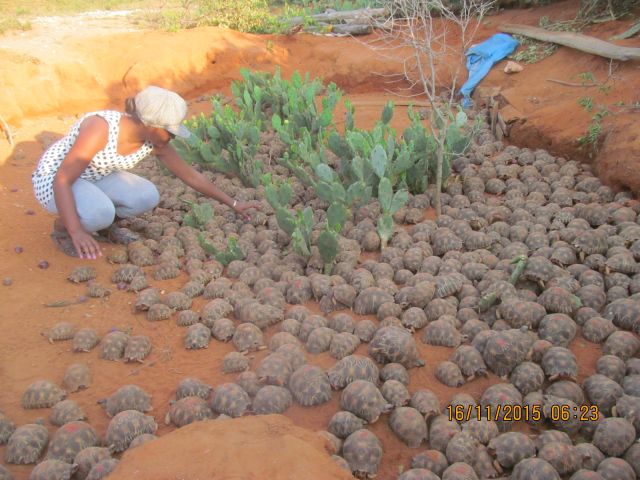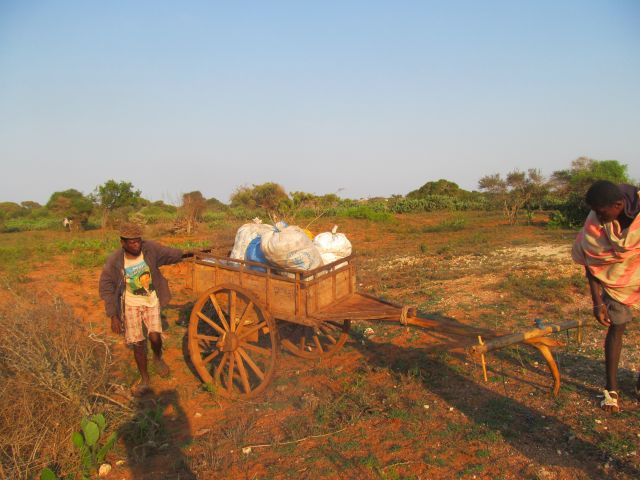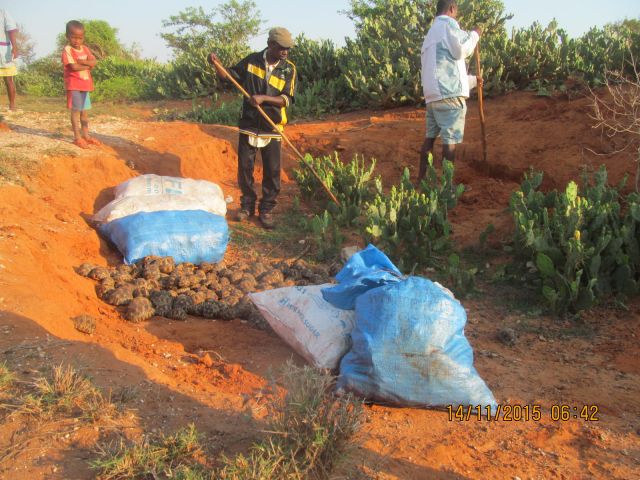Poaching Surges in Madagascar
by Howard Goldstein and Herilala Randriamahazo 




By the end of 2014, the Turtle Survival Alliance lead conservation initiatives in southern Madagascar were showing sufficient success against the poaching crisis that there was very real reason to announce the cautious hope that the tide was now turning in favor of tortoises. One year later in the final weeks of 2015, there is real fear that the Radiated Tortoise may be heading for extinction in the wild much faster than we previously believed.
After several years of steady progress, a massive poaching crisis has resurfaced in 2015, with record numbers of live tortoises confiscated or the discovery of empty shells strewn about killing fields from the bushmeat trade.
The Radiated Tortoise (Astrochelys radiata) is noted for two superlatives: it is arguably the most beautiful tortoise species in the world, and it has gone from superabundant to critically endangered within a shockingly fast timeframe.
The status of Madagascar's Radiated Tortoise eerily parallels that of rhinos and elephants on the African mainland; a massive poaching crisis mobilized conservationists into a Herculean effort, the successes ushered in a brief period of cautious optimism shattered by sudden, record-breaking resurgences of poaching and a new state of emergency.
In 2008 the IUCN listing for the radiated tortoise went from a species of least conservation concern to critically endangered. The native spiny forests of southern Madagascar have been reduced to 2% of their original area, replaced mainly by unproductive desert cleared for zebu and crops, and dominated by non-native prickly pear cacti (Opuntia sp). and agave. Yet amazingly, the radiated tortoise has proven very resilient to this massive habitat degradation.
The radiated tortoise has disappeared in about 65% of its original range, with about 20% of that within the last 25 years. The total estimated wild population decreased by over 47% from 12 million in the late 1990s to about 6.3 million in 2013. Six million may sound like a lot of animals, as did 60 million bison in North America in 1830, but by 1900, the entire world population of wild American bison consisted of a few dozens restricted to Yellowstone National Park. The current situation with radiated tortoises is analogous, like looking at the bison population in 1860, midway to near total eradication...except that there are fewer tortoises in an area much smaller than the Great Plains but with a much higher human density. Radiated tortoises are being slaughtered in historically unimaginable numbers, with a removal rate that was 25 times above sustainability in the early 2000s, before the current 2015 escalation of tortoise slaughter and collection.
In response to the sudden mass overexploitation of the first decade of the 21st Century, the Turtle Survival Alliance began taking bold steps in 2011 to halt the decline. The TSA launched several major initiatives, including a tortoise poaching awareness program. This initiative included a film targeting both local and international audiences, training workshops in tortoise management, and the development of a Confiscation to Reintroduction strategy. Perhaps most significantly, this program has been building working relationships with local communities that actively support protecting tortoises.
Historically, almost all of the tribes within the radiated tortoise's range considered eating—or indeed harming in any way—a tortoise to be fady, or strictly taboo based on spiritual beliefs. The sudden poaching surge in Madagascar's south reflects some degree of cultural erosion, but the vast majority of the poaching is being carried out by foreign tribes with no such fady against killing tortoises invading from lands further north in Madagascar. TSA launched a major cultural awareness campaign and helped orchestrate a Dina—a community based pact—throughout villages in the south to uphold their traditional beliefs and actively prevent poaching on their lands.
The initiative was paralleled with increased efforts in spurring law enforcement to arrest poachers and confiscate live tortoises and tortoise meat. In juxtaposition, the Confiscation to Reintroduction Plan sought to build five new tortoise holding facilities to house and rehabilitate confiscated tortoises for eventual release back into the wild.
Despite national law enforcement and funding still compromised in the aftermath of the 2009 collapse of the Malagasy central government, the TSA and our Malagasy allies were slowly turning the tide in favor of tortoise survival. By the end of 2014, four of the five tortoise centers were completed and the Dina was being applied and generating the social mechanisms necessary to slow or stop poaching. Research was underway to develop protocols for reintroducing tortoises back into the wild, and perhaps most remarkably, for the first time, poachers had been arrested and imprisoned by Malagasy authorities.
But the situation suddenly deteriorated in 2015.
Newer, better organized poaching rings have come onto the scene. Mass, macabre tortoise graveyards—killing fields littered with empty, broken shells—bear witness to increasing tortoise slaughter. Poachers have become savvy to the possibility of arrest and have begun hiring local spies to inform them of police presence and to drying tortoise meat which is much easier to conceal and transport than live tortoises, with the additional effect that most poachers now kill tortoises immediately in the field.
The Asian exotic pet trade remains rampant and after seeing a brief hiatus in tortoise smuggling at the international airport in 2014, the problem seems to have exploded only months later. Between January and June of 2015, 817 tortoises had been confiscated by authorities and placed with TSA, including three illegal shipments in succession of 268 juvenile radiated tortoises and 96 adult spider tortoises.
And then it got worse. On July 20, 918 Radiated Tortoises were seized in Lavavolo in southwest Madagascar; 350 radiated tortoises were confiscated in the capital Antananarivo in early September and another 771 tortoises—including Ploughshare Tortoises, a species numbering perhaps less than 400 in the wild--- were seized at Ivato International Airport, bound for Malaysia on September 28; in November, 115 juvenile radiated tortoises were confiscated in the town of Antsirabe. But perhaps the most disturbing case was 1,148 seized in the village of Soamanitra, very close to the Special Reserve at Cap St Marie (CSM) - Madagascar's only dedicated Tortoise reserve in the south and home to arguably the most important – and densest - population of Radiated Tortoises in the world.
But TSA and our allies are stepping up to meet this new threat level.
The good news is that after two unsuccessful attempts by TSA's enforcement officer (Sylvain Mahazotahy) and local gendarmes to arrest the main poacher in this village, he was finally caught with a large cache of tortoises and taken to jail. The tortoises, many believed to have come from CSM, indicates that poachers have begun invading difficult to access protected areas formerly considered secure. There is now a very real fear for the future of the tortoise populations atCSM. Further, in an unprecedented move by Malagasy law enforcement, a woman working for the Forestry Department in Toliara was arrested in connection with this case. This arrest of a corrupt member of government in conjunction with tortoise poaching is the first of its kind in the country and could signal a willingness of Government to trace these cases up the supply chain and attack this problem at the source.
Continuing the welcome surge of sudden good news, the Attorney General and President of Judges of the Court of Ambovombe attended the two TSA law enforcement workshops in Tsihombe and Ambovombe recently. Not only does this mark the first time that any judges publicly appeared at tortoise law enforcement workshops, it was far from being a simple passive presence: they presented a strong message that wildlife crimes involving tortoises would not be tolerated and gave an encouraging speech to the participants of both workshops pledging the continued cooperation of the courts in southern Madagascar.
The four TSA tortoise rescue centers are currently holding at maximum capacity, and we are working to complete a fifth center in Itampolo. Our facility in Tana is holding an additional ~1600 tortoises which should be returned to the south as soon as possible. Our primary goal now is the ongoing construction of a centralized Tortoise Conservation Center in the heart of Radiated Tortoise range. We are also facilitating the continued expansion of the "no tortoise poaching" Dina, and refining our anti-poaching networks of local conservationists and Malagasy law enforcement to better combat the changing tactics of poaching rings. Though we have a long way to go before we see the Dina applied evenly throughout the range of the tortoise, there are reports that give us cause for some optimism. In early December 2015, in the community of Ankiliabo, villagers stopped and detained an Army truck because it was carrying tortoises. The mayor alerted their chief of command who demanded that the 43 tortoises be released before they could proceed.
The Radiated Tortoise does not have to become the newest wildlife tragedy; fast and decisive action on the ground can restore our sense of optimism for tortoise conservation in southern Madagascar. However it will take a massive investment in additional resources- both money and boots on the ground- to win this battle. The TSA must vastly increase our presence and visibility in the south if we are to serve as an effective deterrent to poaching, and act an agent of change for improving enforcement capacity. We oftentimes deal with entrenched corruption, and the wheels of justice turn slowly in rural Madagascar, but TSA must be there to ensure that they do not stop or slow down at this crucial juncture.
The TSA wishes to acknowledge the following donors for supporting our efforts to save Madagascar's iconic Radiated Tortoise: The Leona M. and Harry B. Helmsley Charitable Trust, Hogle Zoo, Owen Griffiths, Conservation International, Los Angeles Zoo, Zoo Miami, Turtle Conservation Fund, British Chelonia Group, and Disney's Rapid Response Fund.
